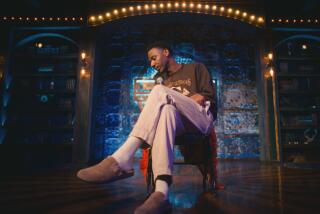Learning to balance food and energy
- Share via
Lance Armstrong is as finely tuned as any race car. Thanks go in part to lead mechanic Chris Carmichael, a former Olympic cyclist and member of the U.S. Bicycling Hall of Fame, who has been Armstrong’s personal coach since 1990.
Carmichael, 43, also has advised Montreal Canadiens hockey player Saku Koivu and two-time Ironman champ Peter Reid, not to mention about 5,000 other professional and amateur athletes who’ve joined Carmichael Training Systems, his online coaching program. Now his expertise is available in print.
“Chris Carmichael’s Food for Fitness: Eat Right to Train Right” (cowritten by Jim Rutberg and Kathy Zawadzki) hit bookstores in late July, a few days before Armstrong’s record-breaking sixth consecutive win in the Tour de France.
One of Carmichael’s bedrock principles is that total calories consumed (and the percent of carbohydrates, proteins and fat in your diet) should fluctuate along with your level of physical activity.
Q: How ignorant is the average person, athlete or not, when it comes to food and nutrition?
A: They don’t take nutrition as seriously as they take other parts of their lives. By and large, they’re uninformed.
Q: What are the warning signs to look for if someone’s not eating properly?
A: One thing they should look for is their energy level dropping off after they work out, or if they’re struggling to do their workout. Another thing to look for is poor sleeping habits, either too much sleep or not enough. Another thing could be cramping when you work out.
Q: You’re critical of low-carb diets. In your book, you say: “They have put too much emphasis on energy intake and too little on energy expenditure.”
A: That’s an overall problem I have with diets in general: We may have lost weight, but have we achieved better health?
A lot of low-carb diets have wreaked havoc on active people who are trying to keep up with that diet. They don’t have the carbohydrates to handle the exercise they’re used to doing. They go out and try to do a triathlon or something, and they can’t make it. They’ve depleted their glycogen stores so much.
Q: In your book and in your work with fitness clients, you suggest keeping a three-day dietary record. What’s to be learned from that? What common misconceptions do people have about themselves?
A: They think they’re eating well or they think they’re not eating as much as they really are.
I talk about “pollutant carrier” foods, which are heavily processed -- lots of trans fatty acids and saturated fats. People tend to underestimate how much of that kind of food they’re taking in.
Q: What basic points would you like people to retain after they read your book?
A: One would be to understand how food affects your life and energy level and, two, that you shouldn’t follow a static diet. It should be dynamic and fluctuate.
The third thing would be to look at food by category. Is what you eat a “quality carrier” food (spinach, whole-grain cereal and other foods high in vitamins and minerals), “empty carrier” (minimally nutritious fare such as soda, white rice and pretzels) or “pollutant carrier” (French fries, doughnuts and other goodies high in calories and fat)?
Q: How educated is Lance Armstrong about nutrition and how his body works?
A: He’s the most fanatical athlete I’ve ever met. It’s like nothing gets by him, from the physical aspect to the technology to nutrition to biomechanics, strength and conditioning.
Q: Lance consumes about 6,000 calories a day during the Tour de France. What is his basic diet?
A: Pasta, rice, potatoes, fish, eggs. When he needs quick energy he likes to eat a PowerBar or PowerGel.
Q: What’s his diet vice, his binge food?
A: Apple fritters are his favorite. Mine is Ben & Jerry’s Heath Bar Crunch ice cream. I try to stay away from it, but every once in a while I break down.
More to Read
Go beyond the scoreboard
Get the latest on L.A.'s teams in the daily Sports Report newsletter.
You may occasionally receive promotional content from the Los Angeles Times.






